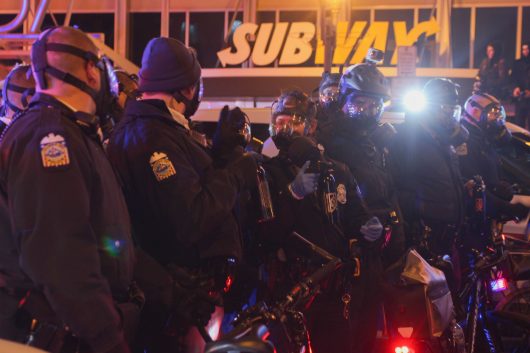
Columbus division of police officers ready their cans of pepper spray on Jan 30. Credit: Mason Swires | Assistant Photo Editor
The Columbus Division of Police held a press conference Friday afternoon to address community questions and concerns about its use of pepper spray on people blocking an intersection as part of a protest on Monday night, although some students were still in disagreement with them.
The protest was one of a litany of demonstrations held in response to President Donald Trump’s sweeping immigration order issued on Jan. 27, which temporarily banned immigration for most citizens of seven Muslim-majority countries, indefinitely suspended the entry of Syrian refugees into the U.S. and temporarily suspended the U.S. refugee-intake program as a whole. The immigration ban, which led to the revocation of tens of thousands of visas, has since been temporarily blocked by a federal judge.
The pepper spray was deployed after the protest, which was estimated to have reached about 2,000 people, had largely cleared out. A few hundred were still downtown, and had blocked an intersection.
Police Chief Kim Jacobs, deputy chiefs Tom Quinlan and Ken Kuebler and Commander Robert Strausbaugh were in attendance to answer questions from both the media and people watching and commenting on Facebook Live.
“You have, absolutely, the right to say what you want to say in this country, but you cannot break the law while you’re doing that,” Jacobs said. “We did make announcements for about 40 minutes the other night. Repeated, ‘Get out of the street, you’re in violation of the law.’”
Some students, however, said Monday night’s series of events was less clear.
Patrick Clearly, a second-year in economics and international studies, was at the protest Monday night before the police began to use pepper spray on the crowd, and said he believes it was not necessary.
Cleary said he left a few minutes prior to protesters being pepper-sprayed, but that he believed police began pepper-spraying people prematurely without giving a fair warning to the protestors still in the street.
“There was really no cause for it, they waited around half an hour before it began,” Clearly said. “The whole time I was there, we didn’t hear the cops say anything. If they were using the speaker it wasn’t loud enough and the (police) sirens were so loud you couldn’t hear over them.”
Jacobs said the department has a history of commitment to working with peaceful protesters, but that occupying public streets without a permit is illegal. She also said that the department was sending a message to protesters Monday night that if they occupy streets without permits, they will be pepper sprayed or arrested.
“So once it becomes this larger crowd that fails to respond to our orders, then they are in violation of the law, and we have the right to do something about it,” Jacobs said.
Jacobs said the use of pepper spray is decided on a case-by-case basis, and determined by the circumstances at the time. She also said the police department stands by its decision to use pepper spray on Monday night.
Jacobs argued that seeing some protesters equipped with gas masks, syringes and face masks indicated protesters were there for “something worse than a peaceful demonstration.”
Cleary, meanwhile, said that the trust between the Columbus police and the community has been tested by the department’s actions on Monday.
“There needs to be some sort of trust there, and the police really violated that trust on Monday,” Clearly said. “I don’t really know how they re-establish that, but to start is to not treat a crowd of innocent people as some sort of invading army.”
Columbus police released a statement Tuesday afternoon stating, “The right to protest, when done according to law, is embedded in the spirit of the Constitution. The role of the Columbus Division of Police during a demonstration is twofold: to protect the rights of peaceful demonstrators and to protect the rights of the public.”


